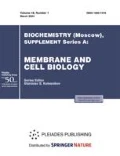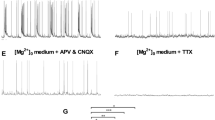Abstract
The mechanisms of hyperexcitability of neuronal networks by ammonium ions and inhibition of this activity by coenzyme NAD were investigated on mixed neuro-glial cultures of rat hippocampus. Ammonium ions cause activation of silent or spontaneously active neuronal networks inducing a bursting electrical activity of neurons and high-frequency synchronous calcium oscillations. In control conditions NAD completely inhibits spontaneous activity of the neuronal network. NAD added after NH4Cl disrupts synchronous oscillation in neurons and splits the network into five populations of neurons. In 4% of cells NAD decreased the amplitude of Ca2+ oscillations, preserving initial mode of oscillations. In 32% of cells, a transient suppression of the neuronal oscillations was observed: inhibition was followed by restoration of the synchronous periodic activity. In 10% of cells, NAD produced a gradual decrease of Ca2+ oscillations down to a complete termination of the initial periodic activity induced by ammonium. Fast and total inhibition of Ca2+ oscillations by NAD was observed in two small groups of neurons. First group (A) participated in the initial spontaneous network activity (5% of cells) with a period of 66–100 s. Second group (B), on the contrary, did not participate in the spontaneous activity. This group of neurons began to pulse with a high frequency (with a period of 6–8 s) synchronously with other neurons in the network after the addition of NH4Cl. Based on the comparison of calcium responses of different cell groups to the depolarization caused by KCl and NH4Cl and to the application of domoic acid, as well as on the results obtained in experiments with fluorescent antibodies against GAD 65/67, parvalbumin, calretinin, and calbindin, we propose that neurons of populations (A) and (B) may belong to GABAergic neurons containing calbindin and parvalbumin, respectively. Further analysis of specificity of the NAD effect on these neuronal groups may allow identification of the main targets of the ammonium toxic action in the brain. Thus, we have shown that NAD selectively inhibits neuronal activity and high-frequency synchronous Ca2+ oscillations in GABAergic neurons containing calcium-binding proteins. The inhibition is accompanied by desynchronization of oscillations and dissociation of neuronal network into several populations.
Similar content being viewed by others
Abbreviations
- NADH:
-
nicotinamide adenine dinucleotide
- GAD:
-
glutamic acid decarboxylase
- CaBP:
-
calcium-binding proteins
- PV:
-
parvalbumin
- CB:
-
calbindin
- CR:
-
calretinin
- DIV:
-
days in vitro
- SSP:
-
spontaneous synchronous pulsation
- DA:
-
domoic acid
- [Ca2+]i :
-
concentration of calcium ions in cytoplasm
References
Sherlock S. 1961. Hepatic coma. Gastroenterology. 41, 1–8.
Nencki M., Pawlow J.P., Zaleski J. 1896. Über den Ammoniakgehalt des Bluttes und der Organe. Die Harnstoffbildung bei den Saugetieren. Arch. Exp. Pathol. Pharmakol. 37, 26–51.
Butterworth R.F. 2002. Pathophysiology of hepatic encephalopathy: A new look at ammonia. Metab. Brain Dis. 17, 221–227.
Schwarz C.S., Ferrea S., Quasthoff K., Walter J., Görg B., Häussinger D., Schnitzler A., Hartung H.P., Dihné M. 2012. Ammonium chloride influences in vitro-neuronal network activity. Exp. Neurol. 235 (1), 368–373.
Dynnik V.V., Kononov A.V., Sergeev A.I., Teplov I.Y., Tankanag A.V., Zinchenko V.P. 2015. To break or to brake neuronal network accelerated by ammonium ions? PLoS One. 10 (7), e0134145.
Belenky P., Bogan K.L., Brenner C. 2007. NAD+ metabolism in health and disease. Trends Biochem. Sci. 32 (1), 12–19.
Liu D., Gharavi R., Pitta M., Gleichmann M., Mattson M.P. 2009. Nicotinamide prevents NAD+ depletion and protects neurons against excitotoxicity and cerebral ischemia: NAD+ consumption by SIRT1 may endanger energetically compromised neurons. Neuromolecular Med. 11 (1), 28–42.
Moreschi I., Bruzzone S., Bodrato N., Usai C., Guida L., Nicholas R.A., Kassack M.U., Zocchi E., De Flora A. 2008. NAADP+ is an agonist of the human P2Y11 purinergic receptor. Cell Calcium. 43 (4), 344–355.
Kilfoil P.J., Tipparaju S.M., Barski O.A., Bhatnagar A. 2013. Regulation of ion channels by pyridine nucleotides. Circ. Res. 112 (4), 721–741.
Zinchenko V.P., Turovsky E.A., Turovskaya M.V., Berezhnov A.V., Sergeev A.I., Dynnik V.V. 2015. NAD selectively inhibits NH4Cl-induced hyperactivity of interneurons containing calbindin. In: Receptors and intracellular signaling. Ed. Zinchenko V.P., Berezhnov A.V. Pushchino: Fix-Print. Vol. 1, p. 252–258.
Grynkiewicz G., Poenie M., Tsien R.Y. 1985. A new generation of Ca2+ indicators with greatly improved fluorescence properties. J. Biol. Chem. 260 (6), 3440–3450.
Hayashi H., Miyata H. 1994. Fluorescence imaging of intracellular Ca2+. J. Pharmacol. Toxicol. Methods. 31 (1), 1–10.
Kononov A.V., Bal N.V., Zinchenko V.P. 2012. Variability of calcium responses of hippocampal neurons to the glutamate receptor agonists. Biol. Membranes (Rus.). 29, 133–138.
Kooijmans R.N., Self M.W., Wouterlood F.G., Beliën J.A., Roelfsema P.R. 2014. Inhibitory interneuron classes express complementary AMPA-receptor patterns in macaque primary visual cortex. J. Neurosci. 34 (18), 6303–6315.
Zinchenko V.P., Turovskaya M.V., Teplov I.Y. Berezhnov A.V., Turovsky E.A. 2015. The role of parvalbumin-containing interneurons in the regulation of spontaneous synchronous activity of brain neurons in culture. Biofizika (Rus.). 60 (6) (in press).
Gall D., Roussel C., Nieus T., Cheron G., Servais L., D’Angelo E., Schiffmann S.N. 2005. Role of calcium binding proteins in the control of cerebellar granule cell neuronal excitability: Experimental and modeling studies. Prog. Brain Res. 148, 321–328.
Dudina Y.V. 2005. State of NADPH-diaphorase and calcium-binding proteins in the neurons of the hippocampal formation in induced by kainate experimental epilepsy in rats. Bull. Experim. Biol. Med. (Rus.). 139 (3), 287–290.
Author information
Authors and Affiliations
Corresponding author
Additional information
Original Russian Text © V.P. Zinchenko, E.A. Turovsky, M.V. Turovskaya, A.V. Berezhnov, A.I. Sergeev, V.V. Dynnik, 2016, published in Biologicheskie Membrany, 2016, Vol. 33, No. 2, pp. 150–158.
Rights and permissions
About this article
Cite this article
Zinchenko, V.P., Turovsky, E.A., Turovskaya, M.V. et al. NAD causes dissociation of neural networks into subpopulations of neurons by inhibiting the network synchronous hyperactivity evoked by ammonium ions. Biochem. Moscow Suppl. Ser. A 10, 118–125 (2016). https://doi.org/10.1134/S1990747816020124
Received:
Accepted:
Published:
Issue Date:
DOI: https://doi.org/10.1134/S1990747816020124



